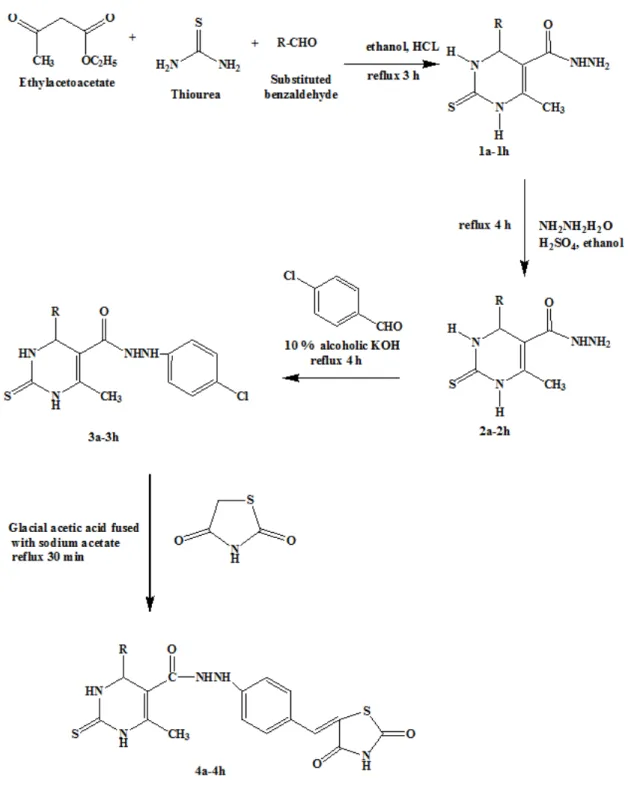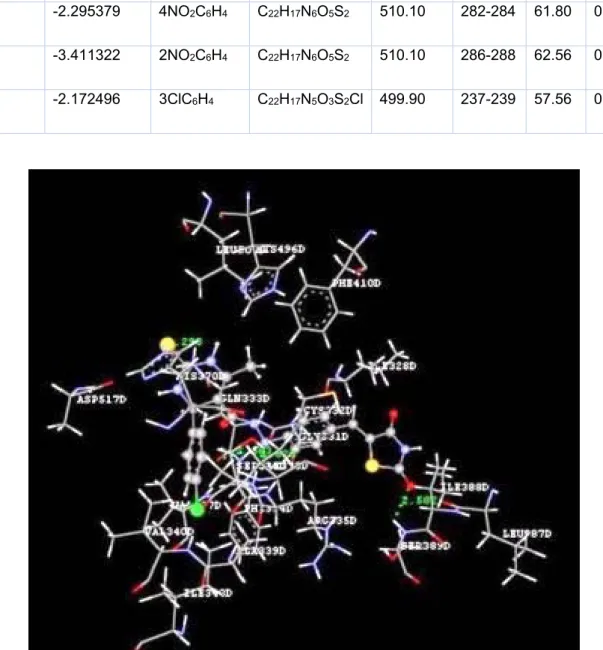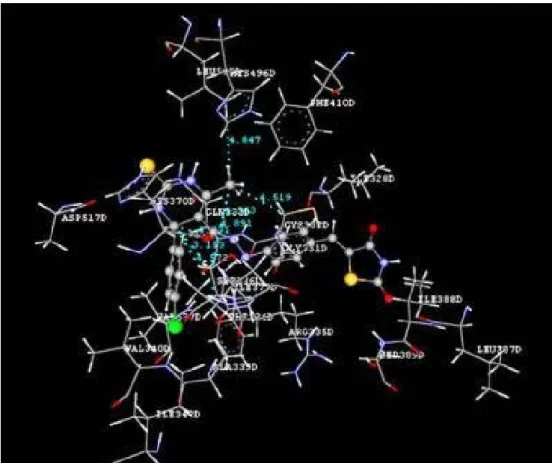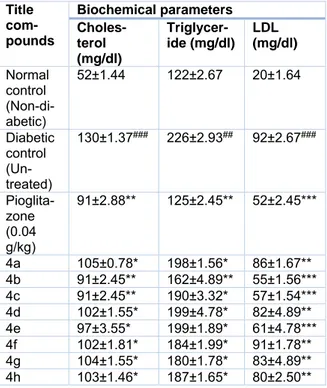Original article:
TARGETING PPAR-γ TO DESIGN AND SYNTHESIZE ANTIDIABETIC THIAZOLIDINES
Ramesh L. Sawant1*, Jyoti B. Wadekar2, Santosh B. Kharat1, Hitakshi S. Makasare3
1 Department of Pharmaceutical Chemistry and PG studies, Dr. Vithalrao Vikhe Patil Foundation’s College of Pharmacy, Savitribai Phule Pune University, Ahmednagar- 414111, India
2 Department of Pharmacognosy, Dr. Vithalrao Vikhe Patil Foundation’s College of Pharmacy, Savitribai Phule Pune University, Ahmednagar- 414111, India
3 Department of Pharmaceutical Chemistry, VIVA Institute of Pharmacy, University of Mumbai, Palghar- 401303, India
* Corresponding author: Department of Pharmaceutical Chemistry and PG studies, Dr. Vithalrao Vikhe Patil Foundation’s College of Pharmacy, Savitribai Phule Pune Uni- versity, Ahmednagar- 414111, India. E-mail: sawantrl@yahoo.com; Tel.: +919850150735
http://dx.doi.org/10.17179/excli2018-1325
This is an Open Access article distributed under the terms of the Creative Commons Attribution License (http://creativecommons.org/licenses/by/4.0/).
ABSTRACT
A series of thiazolidine derivatives were designed by docking into PPAR-γ active site. The structure of target was obtained from the protein data bank (PDB ID P37231). A library of 200 molecules was prepared on random basis.
Molecular docking studies were performed using VLife MDS 4.3 software. After molecular docking studies, the 4-substituted-6-methyl-2-thioxo-1,2,3,4-tetrahydropyrimidine-5-carboxylic acid N-[4-(2,4-dioxo-thiazolidin-5- ylidenemethyl)-phenyl]-hydrazides (4a-4h) were selected for synthesis. The progress of reaction and purity of the synthesized compounds were monitored by TLC and melting point. Structures of title compounds were confirmed by elemental analysis, IR, 1H NMR and mass spectral data. The antidiabetic activity of title compounds was per- formed using the Wistar rats by alloxan-induced method. The compounds have shown antidiabetic activity com- parable with the standard drug pioglitazone. These findings suggest that potent antidiabetics can be generated by substituting nonpolar, electron withdrawing substituents at the fourth position of pyrimidine skeleton and hydrogen bond acceptor at the nitrogen of the thiazolidine nucleus, to inhibit peroxisome proliferator-activated receptor-γ.
Keywords: alloxan, antidiabetic, docking, PPAR-γ, thiazolidine
INTRODUCTION
Diabetes mellitus refers to a group of dis- orders that effects the body’s ability to pro- duce or respond to the hormone insulin, real- izing abnormal metabolism characterized by hyperglycemia (Malecki and Klupa, 2005).
Globally, diabetes has shadowed the spread of modern lifestyle associated with an over- weight and sedentary population (Moller,
2001). The chronic metabolic disorder dis- turbs 150 million people and may rise to 300 million by 2025 worldwide (Kothari et al., 2005). Diabetic patients suffer from cardio- vascular, eye, kidney, and nerve damage which lead to premature handicap and death (Wright et al., 2006).
Peroxisome proliferator-activated recep- tor (PPAR) belongs to the superfamily of a
phylogenetically related protein named as nu- clear hormone factor. PPAR-γ has a place with the group of PPAR which assume a basic part to regulate energy storage and its expres- sion is in endothelial cells (Tyagi et al., 2011).
PPAR-γ activates some genes in tissues that results in an increase in glucose and lipid up- take, decreases free fatty acid concentration, and subsequently decreases the insulin re- sistance (Dumasia et al., 2005). Thiazoli- dinediones (TZDs) are PPAR-γ ligands hav- ing an important structural domain for the de- sign and synthesis of new drugs required to treat type 2 diabetes (Thangavel et al., 2017).
Thiazolidinedione and its derivatives possess diverse nonhypoglycemic effects, for exam- ple, against obesity (Bhattarai et al., 2010), anti-atherosclerotic (Papanas and Maltezos, 2009), antioxidant (Jeong et al., 2004), anti- inflammatory (Shantharam and Chandy, 2011), and anti-cancer (Patil et al., 2010).
Molecular docking is an effective tool for investigating ligand-receptor interactions and for virtual screening, which plays a key role in rational drug design (Sawant et al., 2012).
Here, we describe the design, synthesis, and screening of a new series of 2,4-thiazolidine derivatives using molecular docking studies with the help of VLife MDS 4.3 software. Our efforts are dedicated to obtaining pyrimidine containing thiazolidine analogues having the affinity for PPAR-γ receptor as antidiabetics.
MATERIALS AND METHODS Molecular modelling
Docking studies were performed on VLife MDS 4.3 using grid-based docking method.
The structure of the receptor PPAR-γ was re- trieved from protein data bank (PDB ID- P37231). The receptor was opened in MDS sheet and saved as .mol2 format by removing the water molecule and this enzyme structure was used further for docking purposes. All the chemical structures were drawn in Chem Draw Professional version 15.1. Library of novel 200 analogues was prepared on the ran- dom basis. The protein-ligand complex was constructed and the active site of the enzyme was defined to include residues within a 10.0
Å radius to any of the inhibitor atoms. Batch docking was performed to generate dock score and interactions based on which eight different thiazolidinedione analogues were selected for synthesis.
Chemistry
Eight different 2,4-thiazolidine deriva- tives (4a-4h) were synthesized following Fig- ure 1. The melting point of the synthesized compounds was determined using Veego electronic (VMP-D) apparatus in an open ca- pillary tube. The IR spectra were recorded on Shimadzu FTIR 8400S spectrophotometer and expressed in wave numbers (cm-1), using 1 % potassium bromide discs. The 1H NMR spectra were obtained on BRUKER AVANCEV II 400 NMR spectrometer using DMSO as solvent and TMS as an internal standard. Chemical shifts (δ) are given in ppm. The mass spectra were recorded to know the M+1 peak on LC-MS. The purity of the synthesized compounds was checked by silica gel G plate using chloroform: methanol (9:1) as the mobile phase.
General procedure for the synthesis of 6-methyl-4-phenyl-2-thioxo-1,2,3,4-tetrahy- dro-pyrimidine-5-carboxylic acid ethyl esters (1a-1h)
Thiourea (0.5 mol), ethyl acetoacetate (0.75 mol), and substituted aromatic aldehyde (0.5 mol) were mixed in 25 mL of ethanol. A catalytic amount of concentrated hydrochloric acid (5 drops) was added to the mixture and the mixture was refluxed for 3 h. On cooling, a solid separated was filtered and recrystal- lized from ethanol.
General procedure for the synthesis of 6-methyl-2-thioxo-4-phenyl-1,2,3,4-tetrahy- dro-pyrimidine-5-carboxylic acid hydrazide (2a-2h)
To the mixture of 0.1 mol of compound 1a-1h in 20 mL ethanol, 0.1 mol of hydrazine hydrate and a catalytic amount of concen- trated sulphuric acid was added and the mix- ture was refluxed for 4 h. On cooling, a solid separated was filtered and recrystallized from ethanol.
Figure 1: Synthesis of 2, 4-thiazolidine derivatives 4a-4h
General procedure for the synthesis of 6-methyl-4-phenyl-2-thioxo-1,2,3,4-tetrahy- dro-pyrimidine-5-carboxylic acid N-(4- formyl-phenyl)-hydrazide (3a-3h)
To the mixture of 0.1 mol of compound 2a-2h in 15 mL of 10 % alcoholic potassium
hydroxide, 0.1 mol of para-chlorobenzalde- hyde was added and refluxed for 4 h. On cool- ing, a solid separated was filtered and recrys- tallized from chloroform:ether (1:1).
General procedure for the synthesis of thiazolidinedione
To 0.6 mol of chloroacetic acid in 60 mL of water, 0.6 mol of thiourea was added. The reaction mixture was stirred for 15 min and refluxed for 4 h. On cooling, a solid separated was filtered and recrystallized from ethanol.
General procedure for synthesis of 4-substi- tuted-6-methyl-2-thioxo-1,2,3,4-tetrahydro- pyrimidine-5-carboxylic acid N-[4-(2,4-di- oxo-thiazolidin-5-ylidenemethyl)-phenyl]-hy- drazides (4a-4h)
To 0.25 mol of compound 3a-3h in 50 mL of hot glacial acetic acid, 0.25 mol of thiazol- idinedione, and 1.8 g of fused sodium acetate were added. The reaction mixture was re- fluxed under stirring for 1 h. The mixture was poured into 500 mL water and solid separated was filtered and washed with water, alcohol, and ether. The compounds were recrystallized from glacial acetic acid.
6-Methyl-4-phenyl-2-thioxo-1,2,3,4-tetrahy- dropyrimidine-5-carboxylic acid N’-[4-(2,4- dioxo-thiazolidin-5-ylidenemethyl)-phenyl]- hydrazide (4a)
Melting point: 200-202°C, Yield: 65.82 % IR (KBR, cm-1): 3429.43 (NH stretch), 1651.01 (C=O), 1367 (C-N); 1H NMR (DMSO, 400 MHz, δ ppm): 1.71 (s, 3H, me- thyl), 2.0 (s, 2H, amine), 4.0 (s, 1H, Ar-NH), 4.59 (s, 1H, methine), 6.61-7.22 (m, 9H, CH), 7.57 (s, 1H, ethylene), 8.0 (s, 1H, sec amide), 10 (s, 1H, imid); MS: m/z (M+1): 465.12.
4-(2-Chloro-phenyl)-6-methyl-2-thioxo- 1,2,3,4-tetrahydropyrimidine-5-carboxylic acid N’-[4-(2,4-dioxo-thiazolidin-5-yli- denemethyl)-phenyl]-hydrazide (4b)
Melting point: 210-212°C, Yield: 67.58 % IR (KBR, cm-1): 3429.43 (NH stretch), 1651.20 (C=O), 768 (C-Cl stretch); 1H NMR (DMSO, 400 MHz, δ ppm): 1.71 (s, 3H, me- thyl), 2.0 (s, 2H, amine), 4.0 (s, 1H, Ar-NH), 4.59 (S, 1H, methine), 6.61-7.22 (m, 8H, CH), 7.57 (s, 1H, ethylene), 8.0 (s, 1H, sec amide), 10 (s, 1H, imid); MS: m/z (M+1): 499.9.
4-(4-Chloro-phenyl)-6-methyl-2-thioxo- 1,2,3,4-tetrahydropyrimidine-5-carboxylic
acid N’-[4-(2,4-dioxo-thiazolidin-5-yli- denemethyl)-phenyl]-hydrazide (4c)
Melting point: 225-228°C, Yield: 62.55 % IR (KBR, cm-1): 3323.25 (NH stretch), 1664.57 (C=O), 766 (C-Cl stretch); 1H NMR (DMSO, 400 MHz, δ ppm): 1.71 (s, 3H, me- thyl), 2.0 (s, 2H, amine), 4.0 (s, 1H, Ar-NH), 4.59 (S, 1H, methine), 6.61-7.22 (m, 8H, aro- matic CH), 7.57 (s, 1H, ethylene), 8.0 (s, 1H, sec amide), 10 (s, 1H, imid); MS: m/z (M+1):
499.9.
4-(2-Hydroxy-phenyl)-6-methyl-2-thioxo- 1,2,3,4-tetrahydropyrimidine-5-carboxylic acid N’-[4-(2,4-dioxo-thiazolidin-5-yli- denemethyl)-phenyl]-hydrazide (4d)
Melting point: 229-231°C, Yield: 60.59 % IR (KBR, cm-1): 3429.43 (NH stretch), 1651.01 (C=O), 1367 (C-N), 3245 (C-OH);
1H NMR (DMSO, 400 MHz, δ ppm): 1.71 (s, 3H, methyl), 2.0 (s, 2H, Ar-NH), 4.0 (s, 1H, Ar-NH), 4.59 (s, 1H, methine), 5.0 (s, 1H, Ar C-OH) 6.61-7.22 (m, 8H, aromatic CH), 7.15 (s, 1H, ethylene), 8.0 (s, 1H, sec amide), 10 (s, 1H, imid); MS: m/z (M+1): 481.5.
4-(4-Methoxy-phenyl)-6-methyl-2-thioxo- 1,2,3,4-tetrahydropyrimidine-5-carboxylic acid N’-[4-(2,4-dioxo-thiazolidin-5-yli- denemethyl)-phenyl]-hydrazide (4e)
Melting point: 263-265°C, Yield: 63.81 % IR (KBR, cm-1): 3420.13 (NH stretch), 1652.05 (C=O), 1367 (C-N), 2820 (O-CH3);
1H NMR (DMSO, 400 MHz, δ ppm): 1.57 (s, 3H, methyl), 2.0 (s, 2H, Ar-NH), 3.73 (s, 3H, methyl), 4.0 (s, 1H, amine), 4.59 (s, 1H, me- thane), 6.61-7.22 (m, 8H, aromatic CH), 7.15 (s, 1H, ethylene), 8.0 (s, 1H, sec amide), 10.0 (s, 1H, imid); MS: m/z (M+1): 495.57.
6-Methyl-4-(4-nitro-phenyl)-2-thioxo- 1,2,3,4-tetrahydropyrimidine-5-carboxylic acid N’-[4-(2,4-dioxothiazolidin-5-yli- denemethyl)-phenyl]-hydrazide (4f)
Melting point: 282-284°C, Yield: 61.80 % IR (KBR, cm-1): 3420.12 (NH stretch), 1650.01 (C=O), 1367 (C-N); 1H NMR (DMSO, 400 MHz, δ ppm): 11.10 (s, 3H, me- thyl), 2.0 (s, 2H, amine), 4.0 (s, 1H, Ar-NH), 4.59 (s, 1H, methine), 6.61-8.14 (m, 9H, aro- matic CH), 7.15 (s, 1H, ethylene), 8.0 (s, 1H,
sec amide), 10.0 (s, 1H, imid); MS: m/z (M+1): 510.1.
6-Methyl-4-(2-nitro-phenyl)-2-thioxo- 1,2,3,4-tetrahydropyrimidine-5-carboxylic acid N’-[4-(2,4-dioxothiazolidin-5-yli- denemethyl)-phenyl]-hydrazide (4g)
Melting point: 286-288°C, Yield: 62.56 % IR (KBR, cm-1): 3429.43 (NH stretch), 1651.01 (C=O), 1367 (C-N); 1H NMR (DMSO, 400 MHz, δ ppm): 1.71 (s, 3H, me- thyl), 2.0 (s, 2H, amine), 4.0 (s, 1H, Ar-NH), 4.59 (s, 1H, methine), 6.61-8.07 (m, 8H, aro- matic CH), 7.15 (s, 1H, ethylene), 8.0 (s, 1H, sec amide), 10.0 (s, 1H, imid); MS: m/z (M+1): 510.
4-(3-Chloro-phenyl)-6-methyl-2-thioxo- 1,2,3,4-tetrahydropyrimidine-5-carboxylic acid N’-[4-(2,4-dioxothiazolidin-5-yli- denemethyl)-phenyl]-hydrazide (4h)
Melting point: 237-239°C, Yield: 57.56 % IR (KBR, cm-1): 3430.30 (NH stretch), 1651.01 (C=O), 1367 (C-N); 1H NMR (DMSO, 400 MHz, δ ppm): 1.71 (s, 3H, me- thyl), 2.0 (s, 2H, amine), 4.0 (s, 1H, amine), 4.59 (s, 1H, methine) 6.61-7.22 (m, 8H, aro- matic CH), 7.15 (s, 1H, ethylene), 8.0 (s, 1H, sec amide), 10.0 (s, 1H, imid); MS: m/z (M+1): 499.
Pharmacological screening Antidiabetic activity
Wistar rats of either sex weighing be- tween 150-200 g were utilized for the study.
The animals were housed under controlled conditions with standard pellet diet and water ad libitum. The ethical clearance was ob- tained from the Institutional Animal Ethical Committee (Registration No.: 1670/PO/Re- BiBt/S/12/CPCSEA, dated 02/05/2013). Dia- betes was induced in the rats by intraperito- neal injection of alloxan monohydrate (S.D.
Fine Chemicals, Mumbai) in the ice cold cit- rate buffer, pH 4.5 at a dose of 120 mg/kg.
The diabetic state was confirmed 48 h after alloxan injection by the loss of body weight and hyperglycemia. The rats with blood glu- cose level 200-350 mg/dl were selected for the study.
The rats were divided into three groups, each carrying six animals. Group I served as a diabetic control and received 0.3 % CMC, orally and alloxan. Group II served as a posi- tive control and received a standard drug pioglitazone (0.04 g/kg). Group III comprised of 8 subgroups for 8 title compounds to be tested. Group IV served as the normal un- treated group. The treatment was continued for 8 d by administering the test compounds in 0.3 % CMC orally. On the ninth day, blood samples were collected by the tail tip cut method under mild ether anesthesia. Serum was separated by centrifuging the samples at 6000 rpm for 20 min and stored in the refrig- erator until analyzed. The serum analysis was performed for blood glucose level, choles- terol, triglycerides, and low-density lipopro- tein (LDL) following the kit manual. The quantitative measurements were made on six animals in each group and the value of bio- chemical estimations are expressed as mean ± SE. The data obtained were subjected to one- way ANOVA followed by Tukey test.
RESULTS AND DISCUSSION Docking studies
Docking studies of the title compounds with PPAR-γ yielded docking score ranging from -1.06 to -4.64 (Table 1). The compound 4b shows the highest negative dock score of -4.64. All the docked compounds were ana- lyzed for various types of interactions like hy- drogen bonding, hydrophobic bonding and Van der Waals interactions with PPAR-γ re- ceptor. The compound 4b binds with PPAR-γ receptor by forming hydrogen bond interac- tions with amino acid residues HIS370D and ASP517D (Figure 2) whereas hydrophobic interactions with amino acid residues LEU500D and SER336D (Figure 3) and Van der Waals interactions also. The compound 4b shows similar hydrophobic interactions compared to the standard drug, pioglitazone (Figure 4).
Table 1: Physicochemical properties of the title compounds Com-
pound code
Dock score
(kcal/mol) Structure
(R) Molecular
formula Molecu- lar weight
Melting point (°C)
Yield (%) Rf
value 4a -4.223832 C6H5 C22H19N5O3S2 465.12 200-202 67.58 0.81 4b -4.637163 2ClC6H4 C22H17N5O3S2Cl 499.90 210-212 66.56 0.75 4c -1.822197 4ClC6H4 C22H17N5O3S2Cl 499.90 225-228 62.55 0.65 4d -1.060374 2OHC6H4 C22H18N5O4S2 481.50 229-231 60.59 0.72 4e -4.204622 4OCH3C4H4 C23H20N5O4S2 495.10 263-265 63.81 0.82 4f -2.295379 4NO2C6H4 C22H17N6O5S2 510.10 282-284 61.80 0.78 4g -3.411322 2NO2C6H4 C22H17N6O5S2 510.10 286-288 62.56 0.64 4h -2.172496 3ClC6H4 C22H17N5O3S2Cl 499.90 237-239 57.56 0.85
Figure 2: Ligand receptor interaction diagram showing hydrogen bond interactions of compound 4b at the binding site of PPAR-γ
Figure 3: Ligand receptor interaction diagram showing hydrophobic interactions of compound 4b at the binding site of PPAR-γ
Figure 4: Ligand receptor interaction of standard drug pioglitazone at the binding site of PPAR-γ
Chemistry
Figure 1 outlines the synthetic pathway to obtain the title compounds 4a-4h. Ethyl aceto- acetate was condensed with thiourea and sub- stituted aldehyde in concentrated hydrochlo- ric acid as a catalyst to get 6-methyl-4-phe- nyl-2-thioxo-1,2,3,4-tetrahydro-pyrimidine- 5-carboxylic acid ethyl esters (1a-1h). The compounds 1a-1h were treated with hydra- zine hydrate in ethanol in the presence of the concentrated sulphuric acid as a catalyst to get 6-methyl-2-thioxo-4-phenyl-1,2,3,4-tetrahy- dro-pyrimidine-5-carboxylic acid hydrazide (2a-2h). The compounds 2a-2h were refluxed with alcoholic potassium hydroxide and para- chloro benzaldehyde to obtain 6-methyl-4- phenyl-2-thioxo-1,2,3,4-tetrahydro-pyrimi- dine-5-carboxylic acid-N’-(4-formyl-phe- nyl)-hydrazide (3a-3h). The thiazolidine was synthesized in bulk by refluxing chloroacetic acid and thiourea in an aqueous medium. The compounds 3a-3h in glacial acetic acid were refluxed with thiazolidine and fused sodium acetate to yield the title compounds 4a-4h.
The reaction progress and purity of the syn- thesized compounds were monitored by TLC using silica gel G and by determining its melt- ing point. Structures of the title compounds were confirmed by IR, 1H NMR, and mass spectral data.
Antidiabetic activity
Alloxan-induced beta cell cytotoxicity is a well-established animal model to study anti- diabetic activity (Surana et al., 2008). In this study, we observed a decrease in the blood glucose level in both normal and alloxan dia- betic rats when treated with the title com- pounds. The possible mechanism by which the title compounds brings about its hypogly- cemic action may be by binding to PPAR-γ receptor as a potent agonist and increase the body’s insulin sensitivity (Hauner, 2002). The untreated diabetic rats displayed a signifi- cantly higher blood glucose level compared to the control. After treatment with the title com- pounds, apparently, the title compounds show significant (P<0.001) decrease in the blood
glucose level. The compound 4b shows sig- nificant (P<0.001) reduction in the blood glu- cose level and results are comparable to refer- ence drug, pioglitazone.
Alloxan treated rats demonstrated sub- stantial weight loss and furthermore influence carbohydrate and lipid metabolism. All the ti- tle compounds were found to be effective in restoring the body weight of the animal to a normal value (Table 2).
In a diabetic condition, insulin insuffi- ciency prompts a high serum lipid concentra- tion that causes mobilization of free fatty ac- ids in the peripheral depots. Insulin inhibits the hormone-sensitive lipase in the adipose tissue. Glucagon additionally inhibits the mo- bilization of free acids from the adipose tissue that results in a decrease in the free fatty acid level in the plasma (Chaudhry et al., 2007). In this study, diabetes-induced animals treated with the title compounds show significant (P<0.001) effect on cholesterol, triglyceride, and LDL level (Table 3). The compound 4b
Table 2: Effect of the title compounds on body weight and blood glucose level
Groups Body weight (mg)
Blood glucose level (mg/dl) Normal
control (Non-dia- betic)
170±3.44 110±2.46
Diabetic control (Untreated)
285±4.88## 352±2.45###
Pioglita- zone (0.04 g/kg)
180±2.45** 116±1.51***
4a 177±2.76** 120±3.64***
4b 187±1.78** 119±3.51***
4c 180±3.76** 132±1.09***
4d 176±2.55** 120±2.02***
4e 180±1.45** 145±1.45**
4f 190±2.11** 121±4.07***
4g 190±1.89** 137±1.98***
4h 182±1.79** 135±1.90***
n=6. Values are expressed as Mean ± SD. **=p <
0.01, ***=p < 0.001 when compared with diabetic control, ## = p < 0.01, ### = p < 0.001 when com- pared with normal control. Statistically analyzed by One Way ANOVA followed by Tukey test.
exhibits the highest decrease in cholesterol, triglyceride and LDL level in the reported se- ries, simply as observed in the diabetic rats treated with pioglitazone.
Table 3: Biochemical parameters of normal and experimental animals on day 8, post treatment
Title com- pounds
Biochemical parameters Choles-
terol (mg/dl)
Triglycer- ide (mg/dl)
LDL (mg/dl) Normal
control (Non-di- abetic)
52±1.44 122±2.67 20±1.64
Diabetic control (Un- treated)
130±1.37### 226±2.93## 92±2.67###
Pioglita- zone (0.04 g/kg)
91±2.88** 125±2.45** 52±2.45***
4a 105±0.78* 198±1.56* 86±1.67**
4b 91±2.45** 162±4.89** 55±1.56***
4c 91±2.45** 190±3.32* 57±1.54***
4d 102±1.55* 199±4.78* 82±4.89**
4e 97±3.55* 199±1.89* 61±4.78***
4f 102±1.81* 184±1.99* 91±1.78**
4g 104±1.55* 180±1.78* 83±4.89**
4h 103±1.46* 187±1.65* 80±2.50**
n=6. Values are expressed as Mean ± SD.* = p <
0.05, **=p < 0.01, ***=p < 0.001 when compared with diabetic control, ## = p < 0.01, ### = p < 0.001 when compared with normal control. Statistically analyzed by One Way ANOVA followed by Tukey test.
CONCLUSION
The present study reveals that potent anti- diabetic compounds may be obtained by sub- stituting nonpolar, electron withdrawing sub- stituents at the 4th position of pyrimidine skel- eton and hydrogen bond acceptor at the nitro- gen of the thiazolidine nucleus, by inhibiting peroxisome proliferator-activated receptor-γ.
REFERENCES
Bhattarai BR, Kafle B, Hwang JS, Ham SW, Lee KH, Park H, et al. Novel thiazolidinedione derivatives with anti-obesity effects: dual action as PTP1B inhibitors and PPAR-γ activators. Bioorg Med Chem Lett. 2010;
20:6758-63.
Chaudhry J, Ghosh N, Roy K, Chandra R. Antihyper- glycemic effect of a new thiazolidinedione analogue and its role in ameliorating oxidative stress in alloxan- induced diabetic rats. Life Sci. 2007;80:1135-42.
Dumasia R, Eagle KA, Kline-Rogers E, May N, Cho L, Mukherjee D. Role of PPAR- gamma agonist thia- zolidinediones in treatment of pre-diabetic and diabetic individuals: a cardiovascular perspective. Curr Drug Targets Cardiovasc Haematol Disord. 2005;5:377-86.
Hauner H. The mode of action of thiazolidinediones.
Diabetes Metab Res Rev. 2002;18(Suppl 2):S10-5.
Jeong TS, Kim JR, Kim KS, Cho KH, Bae KH, Lee WS. Inhibitory effects of multi-substituted benzyli- denethiazolidine-2,4-diones on LDL oxidation. Bioorg Med Chem. 2004;12:4017-23.
Kothari A, Kumar V, Mital A, Ramachandran U, Vats R. Emerging targets for diabetes. Curr Sci. 2005;88:
241-9.
Malecki MT, Klupa T. Type 2 diabetes mellitus: from genes to disease. Pharmacol Rep. 2005;57(Suppl):20- 32.
Moller DE. New drug targets for type 2 diabetes and the metabolic syndrome. Nature. 2001;414:821-7.
Papanas N, Maltezos E. Oral antidiabetic agents: anti- atherosclerotic properties beyond glucose lowering?
Curr Pharm Des. 2009;15:3179-92.
Patil V, Tilekar K, Mehendale-munj S, Mohan R, Ra- maa CS. Synthesis and primary cytotoxicity evaluation of new 5-benzylidene-2,4-thiazolidinedione deriva- tives. Eur J Med Chem. 2010;45:4539-44.
Sawant R, Sarode V, Jadhav G, Wadekar J. Synthesis, molecular docking and cardioprotective activity of 2- methylthio-1,4-dihydropyrimidines. Med Chem Res.
2012;21:1825–32.
Shantharam U, Chandy V. Synthesis and evaluation of novel thiazolidinediones for anti-inflammatory activ- ity. Int Res J Pharm. 2011;2:81-4.
Surana S, Gokhale B, Jadhav R, Sawant R, Wadekar J.
Antihyperglycemic activity of various fractions of Cas- sia auriculata Linn. in alloxan diabetic rats. Indian J Pharm Sci. 2008;70:227-9.
Thangavel N, Al Bratty M, Akhtar Javed S, Ahsan W, Alhazmi HA. Targeting peroxisome proliferator-acti- vated receptors using thiazolidinediones: Strategy for design of novel antidiabetic drugs. Int J Med Chem.
2017;2017:1-20.
Tyagi S, Gupta P, Saini AS, Kaushal C, Sharma S. The peroxisome proliferator-activated receptor: A family of nuclear receptors role in various diseases. J Adv Pharm Technol Res. 2011;2:236-40.
Wright SW, Ammirati MJ, Andrews KM, Brodeur AM, Danley DE, Doran SD, et al. Cis-2,5-dicyano- pyrrolidine inhibitors of dipeptidyl peptidase IV: syn- thesis and in vitro, in vivo, and X-ray crystallographic characterization. J Med Chem. 2006;49:3068-76.




